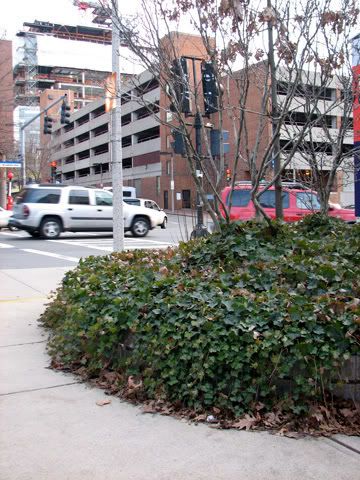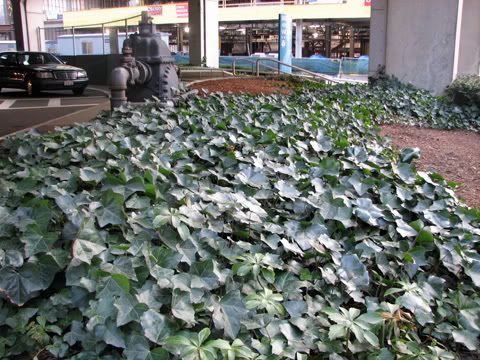365 Urban species. #362: English Ivy

Photos by cottonmanifesto. This planting in Boston's Longwood Medical area has succumbed to its ground cover of ivy, spilling over the edges of its planter.
Urban species #362: English Ivy Hedera helix
While holly has become a symbol tied to a certain holiday, ivy is symbolic of eternal life and fidelity, but is not necessarily associated with Christmas. It clings year-round to the trunks of trees, providing dark green leaves after the tree's own have yellowed and fallen. Even long dead trees standing bare are given the appearance of life with a coating of ivy vines. However the ivy itself may contribute to the demise of the tree it adheres to. Its weight makes the tree more susceptible to storm and ice damage, and the ivy's foliage eventually covers the tree's own, stealing the sunlight.
English ivy is thought to be originally native to central Eurasia, but its attractiveness has encouraged humans to bring it to North and South America, Australia and New Zealand, and many other places. There are hundreds of cultivated varieties available as houseplants, ground cover, and even shrubs and small trees. Ivy takes a decade or more to mature--most urban plantings are a juvenile phase of the plant. It's only when ivy is able to climb a tree or other object that it's able to change into the mature phase and bear flowers and fruit. Ivy is popular as a ground cover because it covers so thoroughly, and its toxic vegetation is resistant to the attentions of rabbits and deer.
Its ability to grow in deep shade makes its presence troubling to woodland stewards. In a forest, ivy may completely overwhelm the habitat, creating what has come to be called an "ivy desert." In the Pacific Northwest a war is being waged against English ivy. In the city of Portland, a group called the No Ivy League has formed to tackle its invasion of Forest Park, the largest urban forest in the country. They attack it by pulling and clipping, but also by encouraging students and researchers to learn more about the plant. For example, its widely thought that birds eat ivy fruit and spread the seeds, but there also seems to be evidence that the fruit is toxic to native North American songbirds. The North American pollinator is likewise unknown. The League also works to educate the public about the ecological danger of ivy, and helped to get the plant listed as a noxious weed by the Oregon Department of Agriculture.

English ivy battles with pachysandra for the habitat of this parking lot planter.